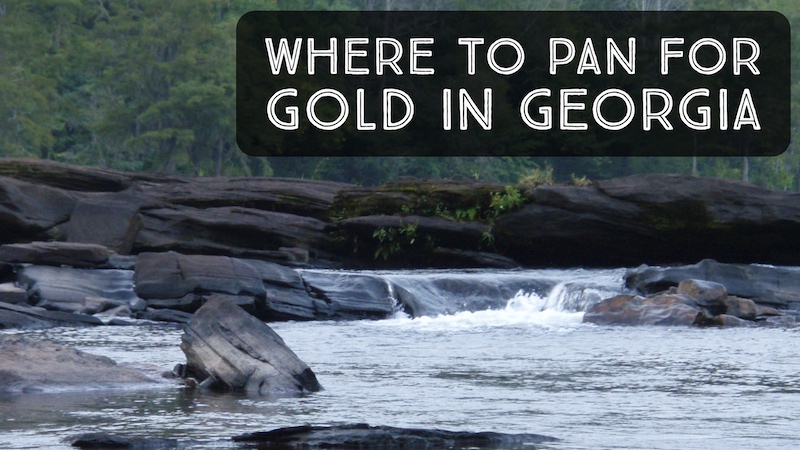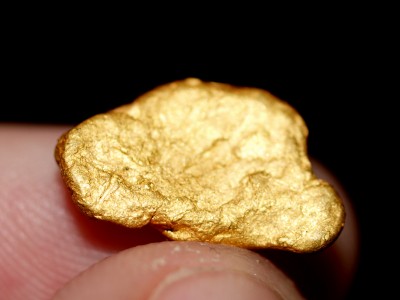
The largest gold producing state in the eastern United States was Georgia. Most of the gold is found within the Carolina Slate Belt, which extends from eastern Alabama up to Virginia. In Georgia, you will often hear this referred to as the Georgia Gold Belt or Carolina Slate Belt.
The largest concentration of gold was found in northern Cherokee, Lumpkin and White counties. Surprisingly, assays of gold in Georgia often turn out to be well above 23 karats, some of the purest natural gold deposits found anywhere on earth. As with other southeastern states, gold here can be found in both lode and placer deposits.
Gold-Bearing Creeks, Rivers and Mines
 Rich placer gold deposits were found in the Etowah and Little Rivers in Cherokee County. The county has also produced large quantities of lode gold that was mine by the Cherokee and Sixes Mines. This area will still produce plenty of gold today.
Rich placer gold deposits were found in the Etowah and Little Rivers in Cherokee County. The county has also produced large quantities of lode gold that was mine by the Cherokee and Sixes Mines. This area will still produce plenty of gold today.
Southeast of Ball Ground on the Etowah River were numerous area prospects and mines, like the Franklin-Creighton Mine, in exposures of decomposed bedrock.
The Sixes Mine are a large group of mines located near Sixes. Several mines are located in this area including the 301 Mine, Cherokee Mine, Clarkston Mine, Downing Creek Mine, Macou, and Putnam Mines. This is a significant gold producing area that has been worked since the start of the gold rush to Georgia.
All the stream and bench gravels contain placer gold around the town of Cumming, especially in James Creek, which flows into the Chattahoochee River. Two miles east of the city was the site where an old hydraulic mining operation was worked.
Northwest of Forsyth County, near the boundary with Gwinnett County in Sugar Hill, was the location of the Simmons Mines, a productive lode gold mine in the area.
The county’s largest waterway is the Tallapoosa River, which flows from its northeastern to southwestern corner. This is very rich country, where placer gold deposits occur throughout the tributaries within the county.
The numerous rich placer gold locations for this historic mining region were situated in all of the regional creeks draining into the Chattahoochee River near Gainsville.
Lumpkin County, which originated and formed as a part of Hall County, was the site where gold was first discovered in Georgia.
 The historic ghost town of Auraria, and the celebrated county seat of Dahlonega in Lumpkin County were the principal sites that attracted attention. For a time, this part of Georgia was getting more focus from gold miners than anywhere in the entire world. The United States Mint even set up a branch in Dahlonega for several years until 1861.
The historic ghost town of Auraria, and the celebrated county seat of Dahlonega in Lumpkin County were the principal sites that attracted attention. For a time, this part of Georgia was getting more focus from gold miners than anywhere in the entire world. The United States Mint even set up a branch in Dahlonega for several years until 1861.
The Chestatee River had numerous mines along its banks, with rich placer gold deposits found throughout. Likewise, the Etowah River contained placer gold, together with its smaller creeks and tributaries like the Baggs, McClusky and Calhoun Creeks.
The nearby Tesnatee River was also a respectable producer of gold, and so was the Yahoola Creek, located in the city of Dahlonega, now the county seat of Lumpkin County. There are other unnamed tributaries in Dahlonega that carried significant quantities of gold as well.
Located in the middle between the rolling hills of Cartersville in Bartow County and the town of Dallas in Paulding County were the many old placer mines that contained placer gold as well as free-milling gold deposits that could be processed with stamp mills.
The Old Twillery Mine was an old placer gold mine. The Yorkville Mine, east of Yorkville by 2.5 miles, was also a producer of free-milling gold. Just southeast of Yorkville is Goldmine Lake and Goldmine Brook, a good indicator that gold has come out of this area before.
Gold Prospecting in Georgia
Georgia was the largest gold producer in the southeastern United States, and there is still lots of gold left to be found here.
There are challenges with mining here just like anywhere though. One difficulty is that pretty much all the land here is privately owned, so you need to get permission before you can access most areas. Becoming a member of a local prospecting club can be a good way to gain access to areas.
Another thing to keep in mind is that these areas were mined hard back during the early gold rush. That isn’t to say that all the gold is gone, but the easy-pickin’s certainly are.
One advantage that we have today is modern prospecting equipment that is much more efficient than the “old timers” ever had. We can find gold that they had trouble capturing.
Gold is widespread here, and there is certainly more yet to be found. While the heyday of gold mining in Georgia may be long over, there are still plenty of prospectors who are successfully finding gold here.
Next: 77 Gold Prospecting Tips – How to Find Gold Like a Pro
Also Read:
The Rich Gold Deposits Found in Alabama
Coker Creek and Tellico Plains – Tennessee Gold
Georgia Fossils and Crystals – Where to Start Your Hunt
Eureka! Big Gold Nuggets Found in North Carolina








